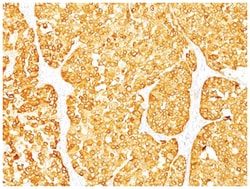Promotional price valid on web orders only. Your contract pricing may differ. Interested in signing up for a dedicated account number?
Learn More
Learn More
Melan-A/MART-1 Mouse, Clone: M2-7C10 + M2-9E3, Novus Biologicals™


Mouse Monoclonal Antibody
Supplier: Novus Biologicals NBP2342450.1MG
Description
Melan-A/MART-1 Monoclonal specifically detects Melan-A/MART-1 in Human, Mouse, Rat samples. It is validated for Western Blot, Flow Cytometry, Immunohistochemistry, Immunocytochemistry/Immunofluorescence, Immunohistochemistry-Paraffin, Flow (Intracellular).Specifications
| Melan-A/MART-1 | |
| Monoclonal | |
| Unconjugated | |
| PBS with 0.05% BSA. with 0.05% Sodium Azide | |
| Antigen LB39-AA, Antigen SK29-AA, Mart 1 Melan A, MART1MART-1, melan-A, melanoma antigen recognized by T-cells 1, Protein Melan-A | |
| Mouse | |
| 21 kDa | |
| 0.1 mg | |
| Cytoskeleton Markers, Immunology | |
| 2315 | |
| Human, Mouse, Rat | |
| Purified |
| Western Blot, Flow Cytometry, Immunocytochemistry, Immunofluorescence, Immunoprecipitation, Immunohistochemistry (Paraffin) | |
| M2-7C10 + M2-9E3 | |
| Western Blot 0.5-1.0ug/ml, Flow Cytometry 0.5-1ug/million cells, Immunocytochemistry/Immunofluorescence 0.5-1ug/ml, Immunoprecipitation 0.5-1ug/500ug protein lysate, Immunohistochemistry-Paraffin 0.5-1ug/ml, Immunohistochemistry-Frozen 0.5-1ug/ml | |
| Q16655 | |
| MLANA | |
| Recombinant hMART-1 protein (M2-7C10; M2-9E3) | |
| Protein A purified | |
| RUO | |
| Primary | |
| This antibody recognizes a protein doublet of 20-22kDa, identified as MART-1 (Melanoma Antigen Recognized by T cells 1) or Melan-A. MART-1 is a newly identified melanocyte differentiation antigen recognized by autologous cytotoxic T lymphocytes. Seven other melanoma associated antigens recognized by autologous cytotoxic T cells include MAGE-1, MAGE-3, tyrosinase, gp100, gp75, BAGE-1, and GAGE-1. Subcellular fractionation shows that MART-1 is present in melanosomes and endoplasmic reticulum. This MAb labels melanomas and other tumors showing melanocytic differentiation. It is also a useful positive-marker for angiomyolipomas. It does not stain tumor cells of epithelial, lymphoid, glial, or mesenchymal origin. | |
| Store at 4C. | |
| IgG |
Product Content Correction
Your input is important to us. Please complete this form to provide feedback related to the content on this product.
Product Title
Spot an opportunity for improvement?Share a Content Correction
